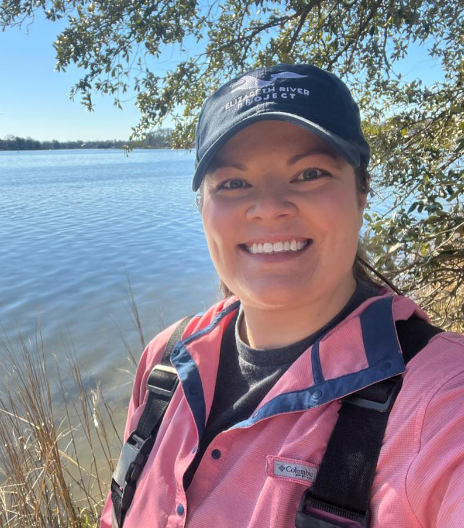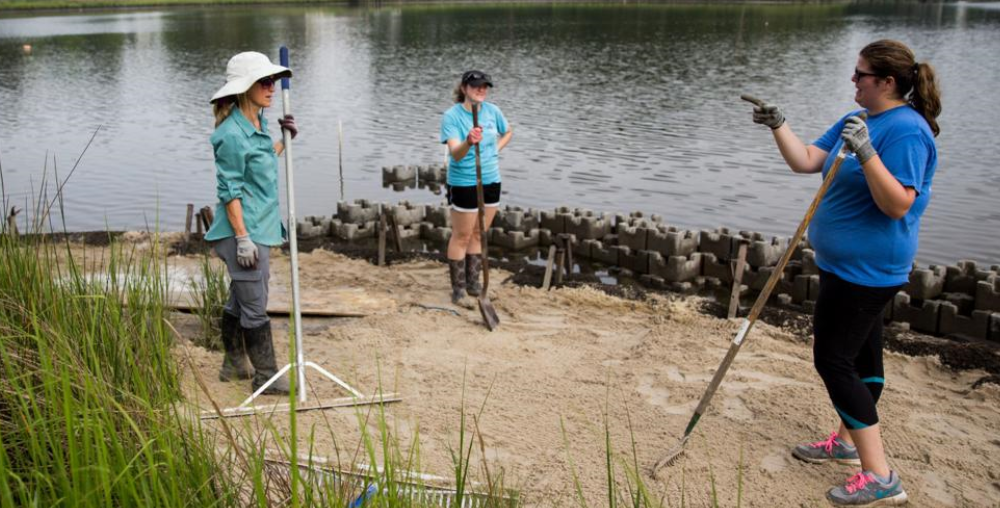In this month’s Living Shoreline Collaborative Partner Highlight we met with Barbara Gavin, Elizabeth River Project’s Environmental Project Manager. Barbara has been working with the LSC since its inception, “recognizing the need for a way to bring together researchers, advocates and the boots-on-the-ground groups creating living shorelines in our region.” Learn more about Barbara below!

Q: Can you tell me a bit about your background?
A: I grew up in Southampton County, Virginia, spending most of my time on the Blackwater River or on the Chesapeake Bay every summer. My family instilled a love for the outdoors, hunting and fishing in me that I have carried through my life. Three generations of my family on both sides worked (and continue to work) at the local paper mill so I like to joke that my dad the forester created a treehugger. While I was at Old Dominion University I landed an internship with the Elizabeth River Project, planting wetlands and meeting community members. I loved the organization’s mission and passion for restoring the Elizabeth. Luckily for me, my predecessor was moving into a new position just as I was graduating with my bachelor’s degree and I was invited to rejoin ERP as the River Star Homes Program Manager.
Q: Can you explain a bit about what your home organization does?
A: The Elizabeth River Project works throughout the entire river watershed and we essentially have three hubs for our work – our Ryan Resilience Lab on Knitting Mill Creek in Norfolk, Paradise Creek Nature Park on Paradise Creek in Portsmouth, and our Learning Barge is docked at Grandy Village Learning Center on the Eastern Branch in Norfolk. Our mission is to restore the Elizabeth River through equitable collaboration with diverse communities, businesses and governments. We focus heavily on educational programming for K-12 and restoration work to impact both the immediate and future health of the river. Our work is guided by a Watershed Action Plan and bi-annual state of the river scorecard created in partnership with dozens of local stakeholders.
Q: Can you explain a bit about what your role is within your organization?
A: I help write and manage federal grants that allow us to do this work, while also working closely with our restoration team while they complete restoration projects such as rain gardens and living shorelines at private properties. I hold the Virginia Class B contractor’s license for ERP, which uniquely sets us apart from other environmental non-profits interested in living shorelines. The Elizabeth River Project is equipped to not only offer technical advice but also the contractor support to get it done from permitting to installation.
Q: How did you first become affiliated with the LSC?
A: I have been with the LSC since the very beginning. I am lucky to have been one of the voices advocating for this group- recognizing the need for a way to bring together researchers, advocates and the boots-on-the-ground groups creating living shorelines in our region. I was thrilled when JRA began the work of creating the group and really believe our membership is what keeps us moving forward. The instructors cannot teach without updated guidance from the researchers, and the researchers cannot collect data without partnerships with projects actively being installed. It is a completely symbiotic relationship.
Q: How has your affiliation with the LSC affected your role and/or the impact of your organization on the geographic area you serve? What is your role in the LSC?
A: My role with the LSC has certainly strengthened my partnerships with the organizations and universities in our region. Being on the steering committee and training team allows me to update our partners on work happening in our area and ensure our priorities for educating marine contractors is incorporated. It has directly benefited our watershed by bolstering an opportunity to work with the James River Association to share our knowledge of living shorelines with them and cost share residential projects. This funding created so much momentum in our area and in Portsmouth especially, where there is ample opportunity for living shorelines but no cost share program available to residents until that point.
Q: What do you hope to accomplish with the LSC in the future?
A: I am excited for the next contractor training with Wetlands Watch and CBF, and for research opportunities provided by this collaborative especially. I want to be continually expanding my knowledge on how we can best adapt these practices to sea level rise and ODU’s work on monitoring the outcomes is really informative for us. I may sound like a broken record, but I am truly grateful for the partnership opportunities the LSC has built over the last few years. It has provided such a boost for marketing living shorelines as well. I am excited to see JRA take the helm and keep working towards resiliency!

